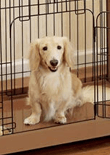10 Crate Training Tips
By Sally Gutteridge | Posts

 The ultimate goal of crate training should be to provide your dog with a safe, cozy, and content environment that they can go to throughout the day and to sleep in at night. Once you acclimate your dog through crate training, it will also make it easier to travel and transport your dog to the groomer or the vet.
The ultimate goal of crate training should be to provide your dog with a safe, cozy, and content environment that they can go to throughout the day and to sleep in at night. Once you acclimate your dog through crate training, it will also make it easier to travel and transport your dog to the groomer or the vet.
If you’re new to crate training, here are 10 basic guidelines you can use to have a positive, productive training experience:
Start slowly by keeping the crate door open with treats inside. After several days of this, close the crate door with the dog inside, and then let him out. After several more days, leave the dog inside for longer and longer periods of time until he becomes comfortable in his new environment.
Session expired
Please log in again. The login page will open in a new tab. After logging in you can close it and return to this page.
does this method stop a puppy to mess up the house ?
It depends on how you define “mess up the house”. I assume that you mean either soiling the house or chewing on something of value. Either case, if your dog is crated when you are not home, and that you supervise him when you are at home, then your puppy won’t have the chance to do either.